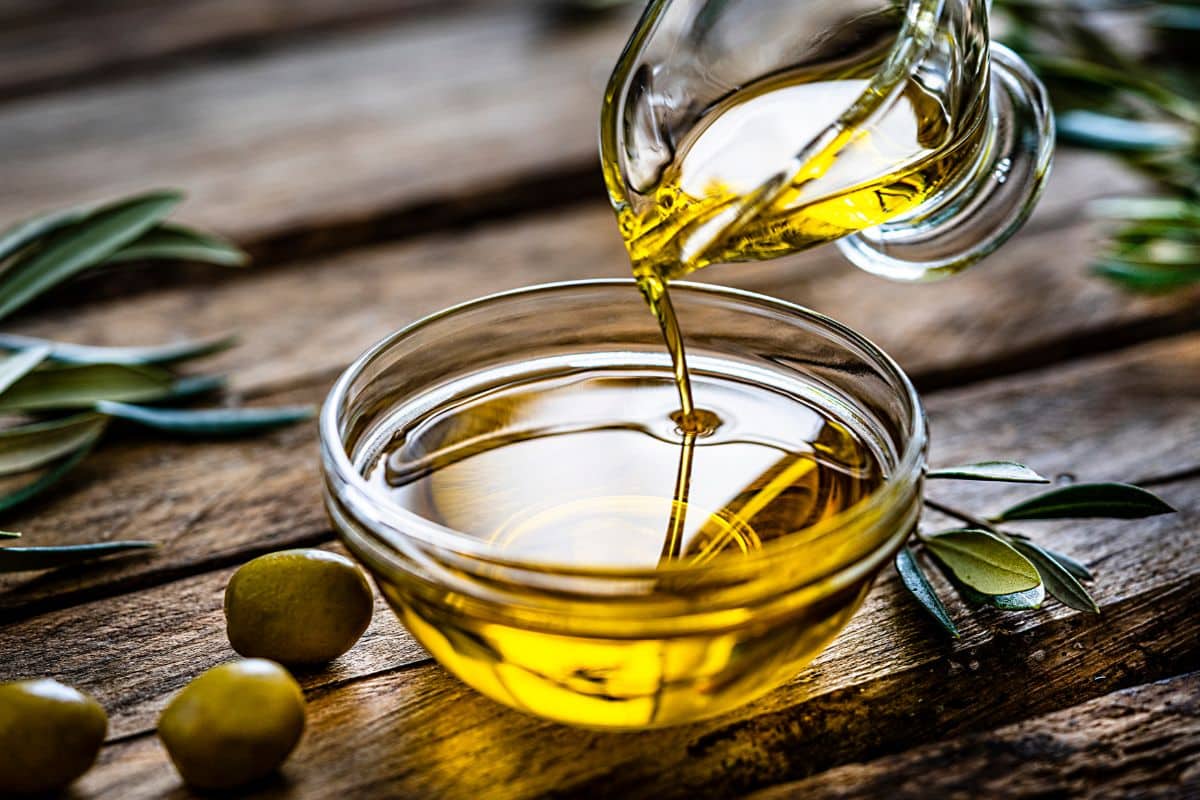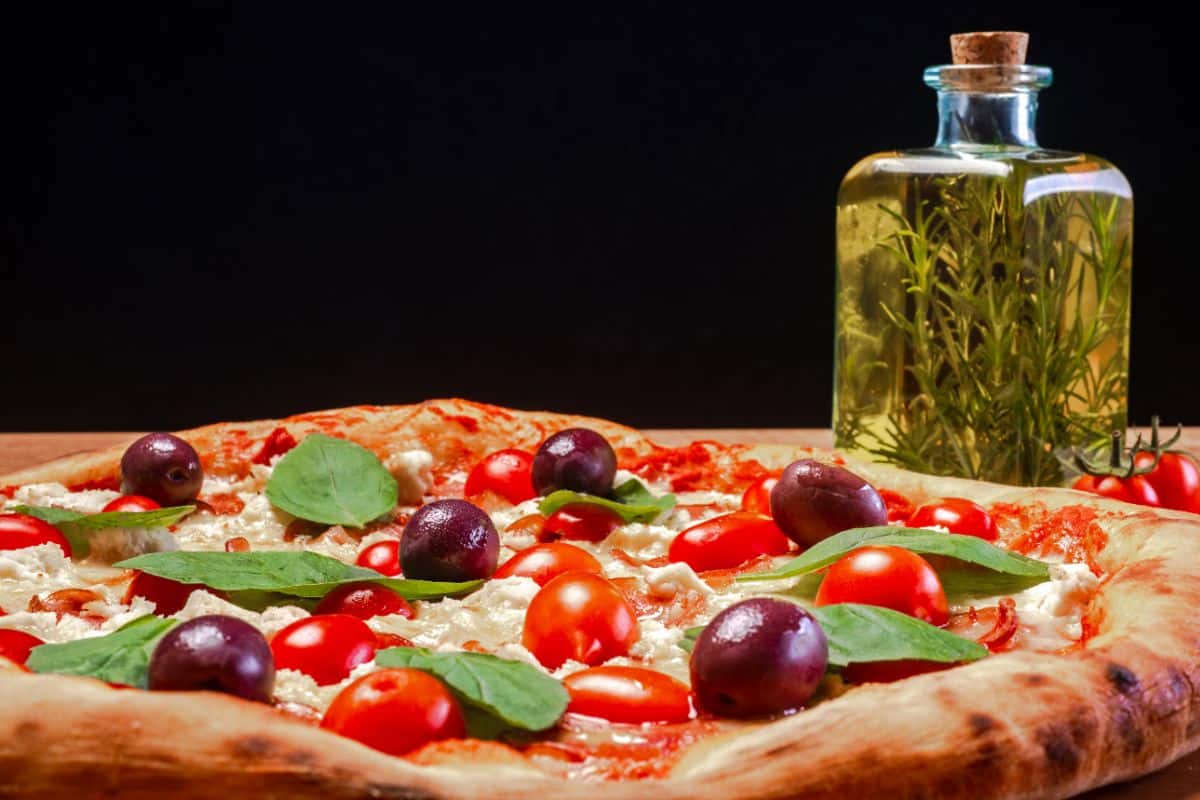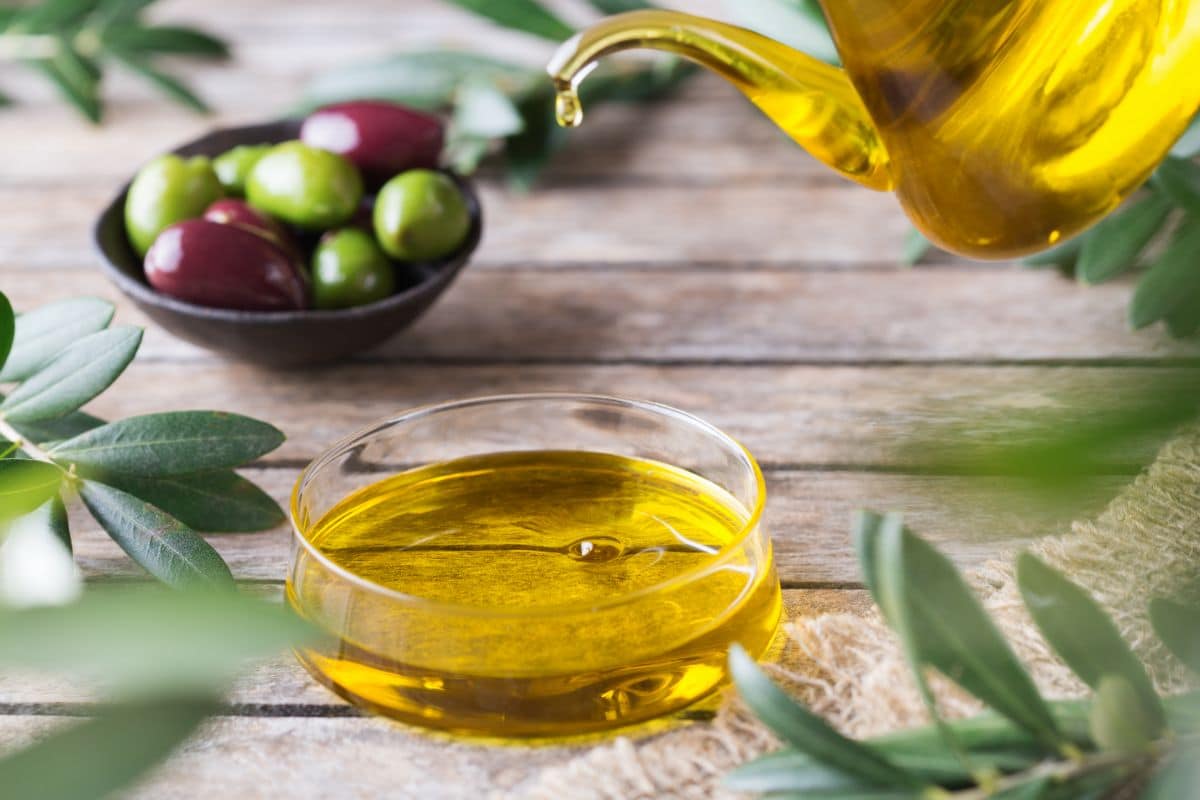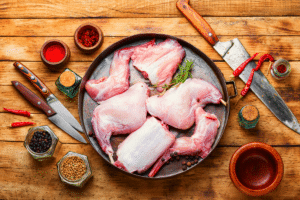Extra virgin olive oil is an excellent source of flavor for many common dishes, from sandwiches and salads to pizzas.

So many recipes call for extra virgin olive oil, but many of us are simply adding it to our food without knowing much about it (other than that it tastes amazing, obviously).
If you’d like to know more about extra virgin olive oil, just keep reading! We’re going to discuss what extra virgin olive oil actually is, how it’s different from your average olive oil, and how you can use it in your day-to-day cooking!
What Is Extra Virgin Olive Oil (EVOO)?
You might sometimes hear extra virgin olive oil referred to as ‘EVOO’. This is simply an abbreviation because, let’s face it, ‘extra virgin olive oil’ can be a bit of a mouthful.
We’d like to thank Rachel Ray for coining this term, and we’re going to be using it throughout this article.
In case you’re wondering how extra virgin olive oil is different from regular olive oil, we should start by mentioning that there are several different varieties of olive oil.
Extra virgin olive oil, specifically, is a type of unrefined olive oil. It’s cold-pressed, and in order to receive the label ‘extra virgin’, it needs to go through several tests and meet all the high standards associated with it.
Many people are skeptical about the difference between extra virgin olive oil and other types of olive oil: ‘Is it all just a clever marketing ploy? Am I about to pay an extra few dollars for oil that’s basically the same as the bottle next to it?’
The good news (if you like to buy extra olive oil, anyway) is that there is a distinct difference in the flavor of extra virgin compared to other kinds of olive oil. Compared to refined olive oil, it tastes somewhat fruity, which means its flavor is more palatable.
Health Benefits Of Extra Virgin Olive Oil
Many people avoid cooking with oils because they worry about the calories and fats in these products. However, there are plenty of benefits to cooking with extra virgin olive oil.
The first and most important benefit is that while olive oil (including extra virgin) does contain a lot of fat, most of these are actually healthy fats. While 14% of calories from extra virgin olive oil does come from saturated fat, 73% come from monounsaturated fat.
These fats, which include omega-3 and omega-6 fatty acids, are beneficial for your heart. They may even reduce your risk of developing heart disease if you consume a couple of tablespoons of olive oil each day, according to the FDS.
Scientific studies have suggested that extra virgin olive oil (and other forms of olive oil) can have positive effects if you suffer from high blood pressure.
It can even help to balance your cholesterol, lowering levels of low-density lipoproteins (LDL) and boosting high-density lipoprotein levels (HDL). Extra virgin olive oil may also help you to maintain healthy skin because of the high levels of vitamin E in the oil.
Another great thing about extra virgin olive oil is that it’s rich in antioxidants. Antioxidants have anti-inflammatory effects, which means they can help reduce your risk of certain cancers (in the case of olive oil, skin cancer, specifically).
Even more studies have pointed to EVOO as a factor in reducing the risk of strokes, cognitive decline, and mental illness, including anxiety and depression. Bear in mind that in many of these studies, it’s not clear whether the correlation equals causation.
However, there is enough evidence to suggest that consuming olive oil, including extra virgin, in moderation will do more good than harm.
Common Uses Of Extra Virgin Olive Oil In Cooking
Sauces And Dressings
Some of the most common foods you’ll find extra virgin olive oil used in include sauces and dressings.
Because EVOO is more flavorful and smooth than other kinds of olive oil, it’s more likely to be added to components of dishes that are specifically designed to add flavor and texture.
One of the most popular sauces made with EVOO is aioli, but you can also find extra virgin olive oil in various dressings based around vinegar and oil.
Not only that, but when you mix extra virgin olive oil with ingredients like garlic, cheese, and basil, it makes for a delicious pasta sauce. The best part? You don’t need to add anything at all to extra virgin olive oil to enjoy it as a sauce.
In many areas of the world, dipping bread and other foods into plain EVOO is commonplace. If you haven’t tried it before, you definitely should!
How To Make Sauce With Extra Virgin Olive Oil?
Want to know how to make an incredible sauce using extra virgin olive oil? There are many ways to approach this, but one of the easiest and tastiest methods is to simply infuse the oil with flavorful ingredients. All you need is:
- Oregano (½ tsp)
- Parsley (½ tsp)
- Red chili flakes (½ tsp)
- Garlic (½ tsp)
- Extra virgin olive oil (½ cup)
- Salt
- Pepper
- Combine all the ingredients in a small bowl, and use a fork to stir the seasoning through the oil.
- Tate a small amount of the oil and add extra seasoning if it’s not potent enough.
- Refrigerate the oil for roughly half an hour to allow the flavors to infuse before serving.
Pizza

Pizza is one of the most popular foods worldwide, and it’s a testament to how delicious EVOO is that many Italian chefs like to add this oil to their pizzas before serving.
In some cases, the oil is added before or during the cooking process so that it reacts chemically with the tomatoes, but EVOO is delicious enough that it can be added right before serving the pizza, and add to the overall flavor.
If you’ve never tried adding extra virgin olive oil to your pizza before eating, you should try it today! We’re going to help you out by telling you exactly how to make an EVOO pizza. To start with, you’ll need:
- Pre-based pizza crust (12 inches)
- Shredded mozzarella (1.5 cup)
- Sliced tomatoes (1 cup)
- Sliced olives (¼ cup)
- Sliced peppers (¼ cup)
- Pesto (¼ cup)
- Preheat your oven, setting the temperature to 450 degrees Fahrenheit.
- Brush the pizza crust with the pesto sauce. You can also add some fresh basil. Next, add a layer of olive oil (not too much!)
- Add the other ingredients to your pizza. Just the cheese as a base, and feel free to add any extras that you like.
- Put your pizza in the oven and wait for roughly 12 minutes. The most important thing is that the cheese should be fully melted.
- Take the pizza out of the oven and leave it to cool down for a few minutes. Then, right before serving, add a couple more teaspoons of extra virgin olive oil!
Can You Heat Up Extra Virgin Olive Oil?
You may have noticed that none of the most common uses of extra virgin olive oil involve heating up the oil. This may seem strange, since other kinds of oil are often used for frying.
Now, first of all, you can heat up extra virgin olive oil. Nothing bad is likely to happen if you do.
However, you just won’t get the most flavor out of your EVOO if you add it to a dish before cooking. That’s why the best uses for this kind of oil are in cold dishes like salad or sandwiches, or dishes that have been cooked before adding the oil (pizza, for example).
But why does cooking extra virgin olive oil impact the flavor? Well, there are two reasons. The first, which we’re going to explain in more detail shortly, is that the smoke point for extra virgin olive oil is quite low.
This means it’s easier to burn than other kinds of oil, and as you can imagine, burnt olive oil doesn’t taste quite as good. Beyond its smoke point, olive oil is also extremely sensitive.
Even leaving this kind of olive oil in bright light or somewhere too warm can cause it to become bland. Therefore, even if you don’t heat it all the way up to its smoke point, you could be compromising the flavor.
If you’re planning to cook at high temperatures, but want to avoid seed oils and the vegetal flavor of vegetable oils, you can still use olive oil. Just avoid using the unrefined EVOO and opt for a cheaper olive oil from the store.
The Smoke Point Of Extra Virgin Olive Oil
As we mentioned earlier, extra virgin olive oil is known for having quite a low smoke point. But what is a smoke point, and what is EVOO’s smoke point, specifically?
To answer your first question, an oil’s smoke point refers to the temperature at which the oil basically begins to burn.
The smoke point is important information to have before you get cooking, because it’s the temperature at which your oil’s flavor and aroma will change (and not in a good way). Compared to other oils, EVOO’s smoke point is not very high.
Now, the exact smoke point may vary depending on which brand you buy, but it tends to sit between 320 degrees Fahrenheit and 400 degrees Fahrenheit. If you compare the smoke point of EVOO to other olive oils, you’ll see the difference.
Virgin olive oil, for example, will only reach its smoke point at 410 to 470 degrees Fahrenheit. For context, virgin olive oil is slightly lower quality than extra virgin, but better quality than standard olive oil (which has a smoke point of around 470 degrees).
Remember, just because extra virgin olive oil hasn’t yet reached its smoke point doesn’t mean it won’t be losing its flavor. Extra virgin olive oil is a sensitive substance, especially when it comes to light and heat, so heating it just a little can impact its flavor significantly.
How To Choose Extra Virgin Olive Oil?
When you buy extra virgin olive oil, you’ll be paying more than you would for a bottle of regular olive oil, or even virgin olive oil. This is to be expected since the main thing that differentiates EVOO from its counterparts is the fact that:
1. Check The Age
Age is one of the most important factors in choosing extra virgin olive oil. Unlike wine, this is not because olive oil gets better with age. In fact, quite the opposite – it gets worse.
If you’re looking for the best quality olive oil, you should look for a date that indicates it’s fresh. Now, of course, ‘fresh’ is a pretty broad term, and you definitely don’t need to try and find a bottle of EVOO that was harvested last week.
You probably wouldn’t have much luck with that. Instead, just focus on finding a bottle of extra virgin olive oil harvested some time within the past 2 years.
2. Don’t Worry About The Color

A lot of people will spend a significant amount of time comparing different olive oil colors and judging them based on this factor. However, we’re here to tell you that you do not need to be a color specialist to choose a good bottle of olive oil.
The color of your EVOO really doesn’t matter. Delicious, authentic extra virgin olive oil can be very pale yellow, any shade of green, or even a dark color approaching mustard. None of this means it will taste or smell a certain way, and it’s not an indicator of quality.
3. Prioritize Dark Bottles
We’ve already established that the color of your extra virgin olive oil doesn’t matter.
However, just to add another reason why you shouldn’t spend half an hour comparing different bottles of EVOO at the store based on color, you shouldn’t be able to see the color clearly through the bottle. Why?
Because ideally, extra virgin olive oil should be stored in a dark container. Many of us are used to seeing extra virgin olive oil sold in clear plastic or glass containers.
Unfortunately, as we mentioned earlier, exposure to heat and light can compromise the flavor and aroma of extra virgin olive oil. If you want your EVOO to last as long as possible and still taste great, you should try and find some in a darkly-colored bottle.
4. Buy From An Olive Estate
Maximizing your chances of getting the best quality extra virgin olive oil often means buying directly from an olive estate.
Depending on where you live, this can be tricky, and it’s certainly more effort (and usually more expensive) than just grabbing a bottle from the grocery store.
If you can’t buy directly from an estate, the next best thing is to look for an estate-labeled bottle of extra virgin olive oil. This is like a stamp of approval that guarantees quality. While we’re on the subject of buying from olive estates, avoid extra virgin olive oil produced in Italy.
We don’t say this because EVOO from Italy is bad by any means. It’s just that the ‘Product of Italy’ label doesn’t actually mean what you think it does most of the time.
You can usually buy from a local estate at much more reasonable prices, and Italian olive oil isn’t always actually made in Italy. Often, the olives are shipped from elsewhere in the Mediterranean and only processed on Italian soil.
5. Do Not Refrigerate
It may seem logical to refrigerate something when you want to keep it fresh, but when it comes to extra virgin olive oil, you want to choose a dark storage space that stays at room temperature pretty consistently.
The cold refrigerator will produce condensation, which can also negatively impact the flavor of the oil.
Final Thoughts
Extra virgin olive oil, or EVOO, is different from other kinds of olive oil because it’s unrefined, which means it’s not as processed. It also goes through more quality testing than other olive oils.
Extra virgin olive oil has many health benefits, from lowering the risk of heart disease to improving skin conditions. It’s also very flavorful. This oil is best added to cold dishes like salads or sandwiches, or hot dishes after the cooking process because it has a low smoke point.
The FDA recommends getting up to 2 tablespoons of extra virgin olive oil in your food every day, so start adding this oil to your cooking today!
Frequently Asked Questions
Roasting potatoes in extra virgin olive oil might sound like a great way to take your potatoes to the next level. However, the reality is that doing this will involve taking the olive oil beyond its smoke point, so it won’t taste as good.
We recommend using regular olive oil, or virgin olive oil, rather than extra virgin. These alternatives have lower smoke points and aren’t as expensive, so if the flavor is compromised, it’s not as much of a waste.
Yes, it is healthy to have one to two tablespoons of extra virgin olive oil every day. Although olive oil does contain a lot of calories, it’s also full of healthy fats, vitamins, and antioxidants.
Another benefit of olive oil, including EVOO, is that it can help to clean your bowels. Drinking a tablespoon of olive oil first thing in the morning, before you have eaten anything, can encourage bowel movements because it acts like a lubricant.
If you are having digestive issues, speak to your doctor about incorporating olive oil into your diet.
Over-consuming any kind of olive oil can lead to side effects and have a negative impact on your health. If you consume too much extra virgin olive oil, you could end up with skin issues, including acne and blackheads.
Additionally, while the monounsaturated fats in olive oil can have many benefits for your heart, too much of the saturated and trans fats in the oil can cause heart conditions and other diseases.
Despite the anti-inflammatory properties of the antioxidants in the oil, drinking too much can result in inflammation and digestive problems.
Extra virgin olive oil may be healthier to cook with than other types of olive oil because it’s unrefined and minimally processed. However, extra virgin olive oil also has a lower smoke point, so it’s easier to ruin its flavor and aroma by cooking it.
Therefore, whether you like to cook with extra virgin olive oil will depend on your priorities. It’s the healthier choice, but it won’t taste as good, which would be a shame given how much more expensive it is.






